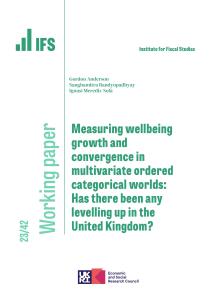Tackling the UK’s deeply entrenched regional inequalities was never going to be easy. Governments of all political stripes have been trying to do something about these economic divides since at least the 1930s, and the latest Levelling Up White Paper is just the latest of these efforts. What does it tell us about this government’s approach? And how likely is it to succeed where others have failed?
The strategy is based around 12 national ‘missions’ which represent a clear – and welcome – statement of what the government wants to achieve. To date, ‘levelling up’ has been little more than a nebulous slogan, and this fills in a lot of the blanks. These missions include, but are not limited to: a boost to R&D spending outside of London and the South East; a narrowing of the gaps in healthy life expectancy between areas; 5G coverage for the majority of the population; and reductions in crime. Many of the missions are framed in both absolute and relative progress. For instance, the government wants to improve well-being in every area of the UK, and close the gap between top-performing and other areas. The government wants to boost pay, employment and productivity in every area of the UK, and also wants to narrow the gaps between regions. This approach is sensible, and hard to argue with.
Every part of England that wants a devolution deal will have one. The government plans to simplify the range of local growth funding pots, and offer local leaders a menu of devolution options – a smart move, and something that we at the IFS have called for previously, in place of the hodgepodge of current arrangements.
There is also a welcome focus on education and skills. The White Paper promises to have hundreds of thousands more people completing high-quality skills training each year by 2030, and includes a commitment that 90% of children leaving primary school in England reach the expected standard in reading, writing and maths by 2030 (up from 65% in 2019). This latter target is astonishingly ambitious. In 2019, just 21 of 151 English local authorities had more than 70% of their pupils meeting the benchmark. Just two – Richmond upon Thames and the City of London – broke 80%. Learning loss during the pandemic means the equivalent figures now are likely even lower. To have any hope of achieving this ‘mission’ (without a moving of the goalposts) schools in all parts of the country will need to significantly up their game.
To illustrate why this focus on skills is so needed, consider the following. Fewer than in one in five children from Grimsby go to university and get a degree. One in three children from London do so. These differences in educational attainment are then compounded by migration decisions: Grimsby loses half of its kids that do manage to get a degree by age 27, while London attracts even more graduates from other parts of the UK. This concentration of high-skilled people and high-paid jobs underpins the geographic inequalities in wages, health, wealth and much else besides.
A focus on educational attainment alone isn’t sufficient. It’s not much use to places like Grimsby if their higher-achieving pupils then move away in search of good jobs. But equally, it’s little good to the current occupants of Grimsby if the government manages to create lots of good jobs in the town, but they’re filled by graduates moving in from elsewhere. This is why, if levelling up is to succeed, it’s so important that the government finds a way to boost educational attainment while simultaneously making high-paid, high-skilled jobs more evenly spread out.
This is, of course, easier said than done. Investments in skills, R&D and transport will likely help a bit, but the government’s hope is clearly that new institutions and ‘system change’ can deliver in the long-term. The White Paper does not exaggerate when it says that a “root and branch reform of government and governance in the UK” will be needed to reshape the UK’s economic geography.
The White Paper is full of ambition. It contains far less on how the various targets, objectives and missions are to be achieved. It is one thing to state that you plan to boost healthy life expectancy by 5 years by 2035, after a decade in which it has stagnated. It is another to have a plan of how to actually achieve it. Much has been made of the fact that the White Paper contains no new funding; instead, departments will be expected to deliver on these missions from within the cash budgets set out in last autumn’s Spending Review. Departments and public service leaders might reasonably ask whether those plans match up to the scale of the government’s newfound ambition – particularly in the face of higher inflation.
We should interpret this week’s Levelling Up White Paper, then, not as a complete blueprint but as a welcome first step. It is a serious piece of policy work, into which a huge amount of civil service time, thinking and effort has clearly been invested. To deliver on the government’s core levelling up ambitions, this level of focus will need to be backed up by funding and sustained over decades.









